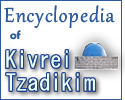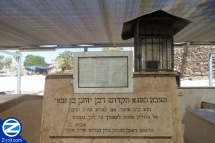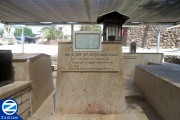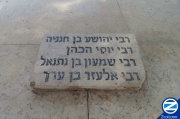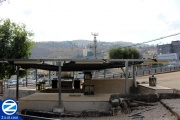Rabbi Yochanan ben Zakkai
Rabbi Yochanan ben Zakkai was a student of Hillel the Elder. After the execution of Rabban Shimon ben Gamliel he succeeded him as Nasi. Foreseeing the upcoming Roman destruction, Rabbi Yochanan ben Zakkai founded the Yavneh academy a few years before the destruction of the Temple. During the siege on Yerushalaim, Rabbi Yochanan favored a peaceful resolution with the Romans but was held back by the Biryonim. Rabbi Yehoshua and Rabbi Eliezer, his two main students managed to smuggle him out of the city, while feigning death, where he was able to meet up with Vespasian but was unsuccessful in saving the city.
Contents |
[edit] Student of Hillel
Hillel the Elder had many students which were led by a group of 80 elite students of which Yonasan Ben Uziel was the highest and Rabbi Yochanan ben Zakkai was the lowest.
[edit] Knowledge
Having been the lowest of Hillel's group of 80 leading students, Rabbi Yochanan ben Zakkai's knowledge is given as an example to show the level of the remaining students and the stature of the Tanaim in general. It was said that he did not leave unturned Scripture, Mishna, Talmud, laws and narratives, details of the Torah and details of the Sages, comparisons and cross-references, astronomical and mathematical calculations, speech of the ministering angels and the speech of demons and the speech of palm trees, parables of launderers and parables of foxes, large matters and small matters. Large matters – the workings of the Divine chariot, and small matters – the discussions of Abaye and Rava.
Mikra - Verses of the Tanach
Mishna - Teaching that encompassing what eventually became formulated as the written Mishna.
Talmud - Logical arguments, deducibles, theories, explanations and expansions on the base teachings of what were to become the Mishna. These were all applied by the Tanim to the teachings of their masters. Much of these were forgotten over the generations since they were not written down and were reestablished by the Amoraim through their analysis of the Mishna, the part of the Oral Torah that was transcribed and formulated.
Halachos - All the instances of 'Halacha L'Moshe MeSeni'
Agados - Homiletical interpretation and expansions of the Torah, many of which were later included in the various Midrashim.
Dikdukay Torah - Halachos and teachings that could be derived from words in the Torah that have missing or additional letters.
Dikdukay Sofrim - Laws and decrees established by various Sages over the years to distance people from committing Biblical transgressions.
Kalim, Chamurim and Gezerah Shava - Teaching derived from comparisons (Kal VaChomer) and cross-references (Gezerah Shava).
Tikufos - Mysteries of the Jewish calendar involving the movements of the sun and the moon used for establishing the new month and leap years.
Gimatriyos - Mathematical calculations based on the numerical equivalence of the Hebrew letters as well as more advanced systems such as Roshi Tevos and Chilufay Osios, one of which is the At Bash system.
Mishalos Kovsim - Parables of launderers used to transmit deep wisdom dressed in analogy.
Mishalos Shualim - Parables of foxes used to transmit deep wisdom dressed in analogy.
Sichas Malachi HaShares - Names of the angles as well as their positions, powers and responsibilities, what roots they eminent from, their manifestations in the physical world and how to bind them by oath to manipulate nature.
[edit] Nassi
[edit] Lecturing in Shade of Temple
Around the time of the holidays Rabbi Yochanan ben Zakkai would sit in Yerushalaim in the shade of the Hichal section of the Beis Hamikdash and lecture the entire day to the masses regrading the laws of the upcoming holiday.[1] Although it is forbid to derive benefit from objects of the Sanctuary, here Rabbi Yochanan had no choice but to lecture outside to the public and was therefore allowed to derive personal benefit from the shade of the Hichal.[1] Additionally the main use of the Hical was its inside so deriving benefit from its outer shade was not considered a practical application of its use and was therefore permitted.[1]
[edit] Passing
Rabbi Yochanan ben Zakkai passed away at age 120. Before his passing Rabbi Yochanan ben Zakkai cried and told his students that he was worried as there were two paths before him, one to Gan Eden and one to Gehinum and he was unsure where he would be led. Big Tzadikim after their passing are often led through Gehinum, so on their way they can raise fallen souls and can continue to serve Hashem even after their passing. This is a very intense and frightening task even for the big Tzadikim, therefore Rabbi Yochanan ben Zakkai was worried about passing though Gehinum. On the other hand if he would be led directly to Gan Eden it would also be an issue since it would be a sign that he was not on the level of passing though Gehuminum to raise the fallen souls.[2]
[edit] Kever Rabbi Yochanan ben Zakkai
Rabbi Yochanan ben Zakkai is buried in the city of Tiberias, near the Kevarim of the Shela and the Rambam. According to some opinions his students Rabbi Eliezer ben Hurkanus, Rabbi Shimon ben Nitanel and Rabbi Yossi HaKohen are buried next to him as well the Amaroim Rav Ami and Rav Asi.
[edit] More Photos
- Kever Rabbi Yochanan ben Zakai Photo Gallery

